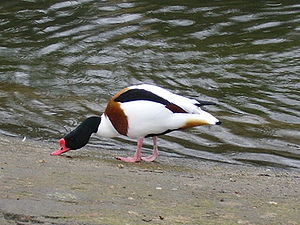Kasarkas
| Kasarkas | ||||||||||||
|---|---|---|---|---|---|---|---|---|---|---|---|---|

Shelduck ( Tadorna tadorna ) |
||||||||||||
| Systematics | ||||||||||||
|
||||||||||||
| Scientific name | ||||||||||||
| Tadorna | ||||||||||||
| Boie , 1822 |
Kasarkas is the name of a genus of goose birds that is assigned to the subfamily of demi-geese . The name Kasarka is borrowed from Russian. However, in Russian this term refers to the geese of the genus Branta .
The seven species represented in this subfamily are characterized by great uniformity in morphology , behavior and ecology. The species live on the edge of the water body and combine characteristics of ducks that are rooting in the shallow water zone and those of the grazing geese of the adjacent pasture areas. Kasarkas are considered to be very aggressive, especially in the breeding season. The females then urge their males to drive other birds or opponents out of the breeding ground. One species, the crested kasarka, has not been seen since 1964 and is believed to be extinct.
In their appearance they differ noticeably from the typical duck habit. The kasarkas species are larger and longer-legged than ducks and therefore resemble geese in their external appearance. The two species of rust goose and shelduck found in the Palearctic are referred to as goose. It is only occasionally that one speaks of the shelduck.
Systematics
The genus Kasarkas includes the following seven recent species :
| German name | Scientific name | distribution | Hazard level Red List of IUCN |
Remarks | image |
|---|---|---|---|---|---|
| Gray-headed Kasarka |
Tadorna cana ( Gmelin , 1789) |
southern africa |
|
monotypical |

|
| Crested Kasarka |
Tadorna cristata ( Kuroda , 1917) |
Northeast Asia |
|
monotypically possibly extinct, last evidence from the 1970s |

|
| Rust goose |
Tadorna ferruginea ( Pallas , 1764) |
Inner Asia to Eastern Europe, Northwest Africa
as a neozoon also in Central Europe |
|
monotypical |

|
| Radjahgans |
Tadorna radjah ( Lesson , 1828) |
New Guinea, Moluccas, Northern Australia |
|
2 subspecies: Indian wheeled goose ( T. r. Radjah ( Lesson , 1828)) Australian wheeled goose ( T. r. Rufitergum Hartert , 1905) only species of the genus in the tropics |

|
| Shelduck |
Tadorna tadorna ( Linnaeus , 1758) |
Europe, Asia |
|
monotypically while the European population predominantly settles coasts, the Asian salty inland lakes prefer |

|
| Australian kasarka |
Tadorna tadornoides ( Jardine & Selby , 1828) |
Southwest and Southeast Australia, Tasmania |
|
monotypical |

|
| Paradise Kasarka |
Tadorna variegata ( Gmelin , 1789) |
New Zealand |
|
monotypically only species with strong sexual dimorphism |

|
supporting documents
Individual evidence
- ↑ Viktor Wember: The names of the birds in Europe - meaning of German and scientific names , Aula-Verlag, Wiebelsheim 2007, ISBN 978-3-89104-709-5 , p. 82
- ↑ Rutschke, p. 322
literature
- T. Bartlett: Ducks And Geese - A Guide To Management. The Crowood Press, 2002, ISBN 1-85223-650-7 .
- Hartmut Kolbe: The world's ducks. Ulmer Verlag, 1999, ISBN 3-8001-7442-1 .
- Erich Rutschke: Europe's wild ducks - biology, ecology, behavior. Aula Verlag, Wiesbaden 1988, ISBN 3-89104-449-6 .